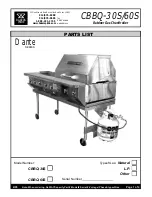
26
Adjust Pilot Burner
Pilot fl ame should surround 3/8” to 1/2” of the pilot sensor,
(Refer to Fig. 21). If fl ame needs adjusting, do it as
follows:
Remove screw cover over pilot adjusting screw on gas
1.
valve.
Insert small screwdriver and adjust fl ame as needed.
2.
Turn screw counterclockwise to increase fl ame,
clockwise to decrease.
Replace screw cover over pilot adjusting screw.
3.
Main Burner(S)
The main burners do not require primary air adjustment
and are not equipped with primary air shutters. Main
burner fl ames should form sharp blue inner cones in a
softer blue outer mantel, with no yellow (Refer to Figure
20). Puffs of air from blowing on the fl ame or stamping on
the fl oor will cause the fl ames to turn orange momentarily.
This is not unusual. Remain still when observing the main
burner fl ames. If the fl ame appearance is not correct,
check main burner orifi ces and the burner throat and fl ame
ports for dust and lint obstruction. It may be necessary
to remove the rollout shield to observe the main burner
fl ames. Replace rollout shield after observation.
Adjust Limit Controls
Instructions for each control are included with the controls.
These settings can be changed after you have had some
idea how the system works. Example: If your system does
not give quite enough heat in very cold weather, you can
raise the limit setting to 220° F Use the boiler gauge to
check your settings. Make the adjustments according to its
readings.
Flame
on
Sensor
Figure 21 - Pilot Flame Adjustment
Burners
A visual check of the pilot end main burner fl ames should be
made at least once each year, preferably at the beginning of the
heating season.
Relief Valve
This valve should open automatically if the system pressure
exceeds the pressure rating (usually 30 psi) of the relief valve.
Should it ever fail to open under this condition, shut down your
system. Drain the system until system pressure is reduced below
the relief valve pressure rating. If valve discharge occurs, or if
valve fails to open as described above, contact an authorized
contractor or qualifi ed service technician to replace the relief
valve and inspect the heating system to determine the cause, as
this may indicate an equipment malfunction.
This valve should be tested every month during periods of boiler
operation, and at the beginning and end of any extended non-
service period. Prior to testing, make certain discharge pipe is
Check thermostat operation. When set above temperature
indicated on the thermometer, boiler should ignite. Make
certain the thermostat turns off the boiler when room
temperature reaches the selected setting and starts
the boiler operating when room temperature falls a few
degrees.
After setting limit control to limit setting, check to see
if it shuts off the gas supply to the burners. Turn your
thermostat up to call for heat and let your boiler run until
the temperature of the water reaches the limit setting. The
gas valve should shut off and the circulator keep running
until the thermostat is satisfi ed, or the water cools enough
to restart the burners through the limit control.
Finally, set the thermostat for the desired temperature.
Special conditions in your home and the location of the
thermostat will govern this setting.
properly connected to valve outlet and arranged so as to contain
and safely dispose of boiler discharge. Test at normal system
operating pressure. Hold the trip lever fully open for at least fi ve
seconds in order to fl ush free any sediment that may lodge on
the valve seat. Then permit the valve to snap shut.
Expansion Tank
As previously noted, this tank may become waterlogged, or
may receive an excess of air. Frequent automatic opening of the
relief valve indicates water logging. A high boiler temperature
accompanied by unusually low radiation unit temperature (and
“knocking”) indicates excess air in tank.
To correct either condition, close the valve between the boiler and
the tank. Drain the tank until it is empty. Check all the tank plugs
and fi ttings. Tighten as necessary. Open the valve between the
boiler and tank. Water will rise to the normal height in the tank
if you have an automatic fi ll valve (otherwise, manually refi ll the
system).
CHECKING AND ADJUSTING
MAINTAINING YOUR BOILER







































